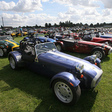You can login to your account or create a new account.
You can login to your account or create a new account.
You can login to your account or create a new account.
Lotus Seven was debuted in 1957 at the Earls Court Motor Show in October of 1957, although it had been planned since 1950s. The Lotus Seven could be purchased assemble or as a kit, for almost half the price. The low price and the versatility, road and race car, made the Seven a success, specially in Clubman races. When production ceased, in 1960, 240 first series Sevens had been built.
Lotus Seven was equipped with a 40 hp Ford or Austin engine commanded by a 3-speed transmission. Anchored in the principle of performance through lightweight, the Seven could reach 140 km/h.
Aluminum Platform (no data) Suspension Double wishbone (front) Solid axle (rear) Steering Rack and pinion Brakes (no data)
Lotus Seven is based on the successful Lotus Mark VI, the first production sports car for Lotus. The Seven was built with racing in mind and the main goal was to make a lightweight car. The roof wasn’t added to keep the weight as low as possible. The first series’ body is made in aluminium. The doors are made of plastic. Overall weight was 450 kg. The first series is the lightest, since the weight kept on increasing in the following series.
Lotus Seven has two seats, which makes it a desirable road car as well.
Lotus
Engineer and racing enthusiast Colin Chapman inaugurated the car company Lotus Engineering Ltd. in 1952, a factory that was firstly located in Hornsey and would only move to Hethel in 1962. Previously, around 1947, Colin Chapman had already built his first automobile based on an Austin 7 chassis. He was still a college student by that time and his extremely light car had been built for competition purposes and would be later called the Lotus Mk1. When hi... more



